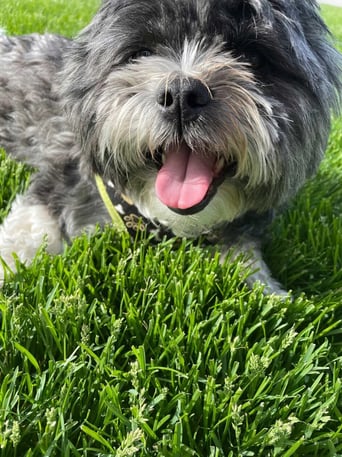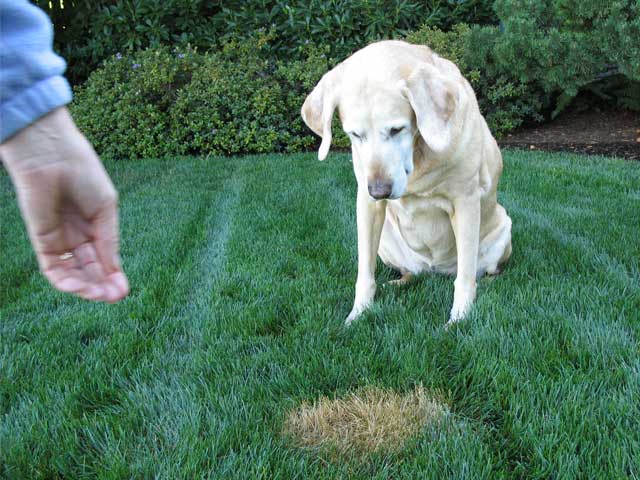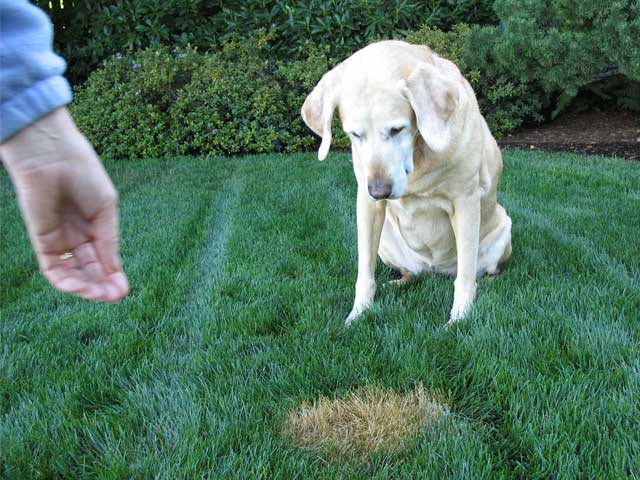
Lawn damage caused by dog urine is not only an unsightly problem but also a common one. It is a challenge for multi-residential building owners/managers to prevent and correct, leaving them frustrated and faced with a lacklustre lawn littered with burn patches that detracts from their building’s curb appeal.
Going to the Dogs
Lawn burn is caused by the high concentration of nitrogen and salts in dog urine. Nitrogen is good for grass but when dog urine is deposited in one small spot the amount is excessive, causing injury or death to the turf. The result is similar to the “burn” caused by over application of lawn fertilizer — the damaged area generally appears as a circular dead patch, with a halo of healthy, dark green grass around its edges. In many instances, the urine damage is severe and the turf will not fully recover on its own. If not properly treated, weeds may eventually invade and replace the lawn grass.
Out, Damned Spot!
There is no magic cure or quick fix for lawn burn. Countless commercially manufactured products and home remedies claim to thwart and/or repair the characteristic yellow/brown scorch spots, but most are ineffective and some can make the problem even worse. Instead, successful treatment requires a multi-step approach.
To begin, it is important to identify dog urine as the cause of the damaged turf. Check to see if the burnt grass is firmly rooted. If a large amount of grass easily pulls up, this might indicate a grub problem — beetle larvae like to feed on the fibrous roots of grass — or, even worse, active lawn disease.
Next, apply granular gypsum to the natural grass to help neutralize the salt concentration in the soil. High salt concentrations make it difficult for turf to extract water from the soil, which circumvents healthy growth. Broadcast applications over large areas or small spot applications are recommended.
If lawn burn is mild, an aggressive combination of core aeration, overseeding and slit seeding will generally repair the damage. Hand spot seeding with a soil and seed mixture is also a good alternative for small one-off spots. Best practice involves lightly raking the damaged area and removing the dead matted down grass. This eliminates a thick layer of dead turf and helps ensure grass seed has optimal seedto- soil contact for increased germination and establishment. It is important to water immediately after seeding and to keep the area moist until seedlings emerge (between 10 to 14 days). Seed establishment takes much longer than new sod and requires daily watering to ensure germination. Newly seeded areas should be roped off to keep traffic from impeding or damaging the new seedlings as establishment takes place.

Severely and extensively damaged lawn (more than 50 per cent of the turf area) may require total renovation. This involves removal of all dead sections of turf, tilling and soil preparation followed by re-sodding. The best times to do this are fall (mid-September to late October) or spring (mid-March to mid-April). New sod generally requires daily watering for several weeks until it has fully rooted. During this time, traffic on newly sodded areas should be kept to a minimum until full establishment.
Re-sodding can be very expensive, though, especially if it must be repeated to combat the dog urine problem. As a result, some building owners/managers are opting to replace their natural grass with synthetic turf since it is indestructible and more cost-effective in the long-run.
Pooch Prohibition
Once repaired, property owners/managers must be proactive in protecting their building’s lawn from future damage.
The most effective way to prevent grass scald is to water the area immediately after a dog has urinated. This will help dilute the concentration of nitrogen. However, it is often impractical for building owners/managers of large communities.
The next best defence is to designate specific areas as non-turf. Lay gravel or mulch for residents’ dogs to specifically use for urination. Be sure to communicate management intentions with building occupants to ensure maximum success.
Motion-activated sprinklers may also be helpful in keeping dogs off grass. Once triggered, these sprinklers operate for a short period of time but long enough to encourage the animal to take its business elsewhere.
Building owners/managers can further reduce stress on their lawn by following recommended mowing practices and irrigation requirements.
This article was published in the September 2015 issue of Canadian Property Management: GTA & Beyond and the May/June 2016 issue of Facility Cleaning & Maintenance
Follow us on Facebook for daily tips & tricks.







